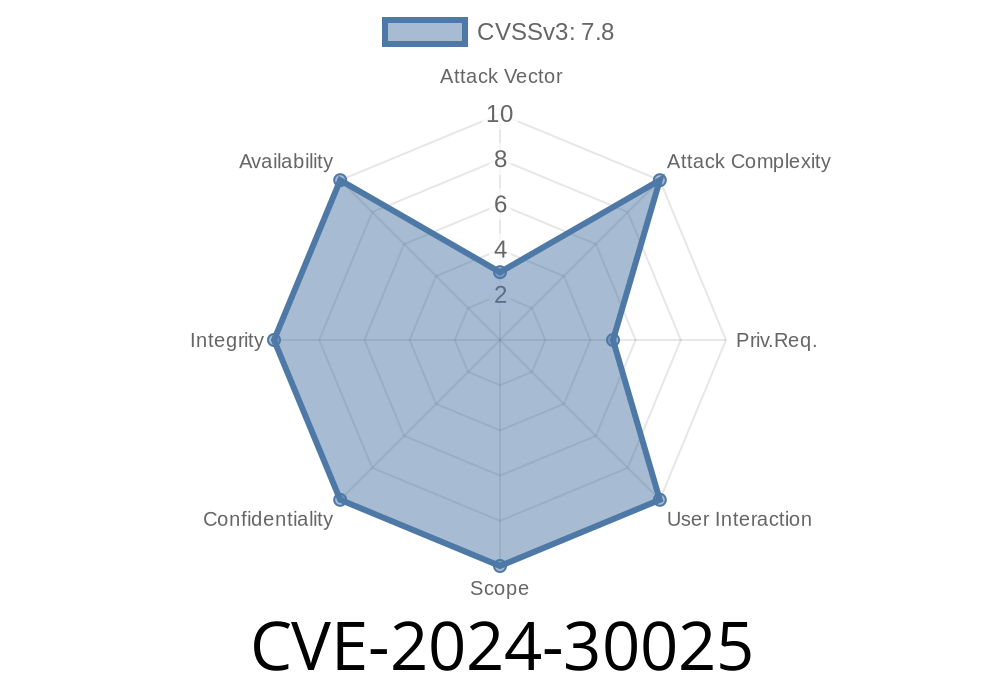Greetings everyone!
Today, we discuss a critical security vulnerability present in the common Windows Log File System Driver, which has been assigned CVE-2024-30025. In this post, we'll dive deep into the technical details of this vulnerability, provide code snippets, links to original references, and a detailed explanation on how to exploit it. Please, follow along carefully as knowing this information may help protect your systems from potential attackers.
Background Information
To understand the CVE-2024-30025 vulnerability, let's first dive into what the Windows Common Log File System (CLFS) driver does. CLFS plays a crucial role in managing logs within Windows operating systems. This driver is responsible for handling log files to facilitate data tracking and auditing, which ultimately ensures system stability.
Recently, a vulnerability has been uncovered in the CLFS driver present in various versions of Windows operating systems, which could potentially lead to privilege escalation. This would enable an attacker who has gained access to a low-privilege user account on the target system to elevate their privileges and gain full control over the system. Now that's scary!
Before diving into the exploit details, please note that Microsoft has already released patches for this vulnerability. It's crucial for everyone to keep their systems updated to avoid falling prey to such threats. For reference, the following link provides information on the updates and patches for affected Windows versions:
- Microsoft Security Updates for CVE-2024-30025
Exploit Details
Now let's get into the technical aspects of this vulnerability. CVE-2024-30025 is caused by a race condition present in the CLFS driver. The race condition occurs when multiple threads access and manipulate the same data concurrently without proper synchronization. This can lead to confusion and unintended behaviors within the CLFS driver.
To exploit this vulnerability, an attacker would need to craft a malicious application specifically designed to manipulate the CLFS driver's internal memory structures. Successfully exploiting this vulnerability could corrupt the memory in such a way that it allows an attacker to gain elevated privileges on the target system.
Below is a simplified example of a code snippet potentially used to exploit this vulnerability. Keep in mind that this is just an example for educational purposes and should not be used for malicious intentions.
#include <Windows.h>
#include <stdio.h>
int main()
{
HANDLE hDevice;
DWORD BytesReturned;
// Open a handle to the vulnerable CLFS driver using CreateFileA
hDevice = CreateFileA("\\\\.\\vulnerable_clfs_device", GENERIC_READ | GENERIC_WRITE, , NULL, OPEN_EXISTING, FILE_ATTRIBUTE_NORMAL, NULL);
if (hDevice == INVALID_HANDLE_VALUE)
{
printf("[-] Failed to open a handle to the vulnerable device. Error code: %d\n", GetLastError());
return 1;
}
// Craft a malicious payload
char malicious_payload[1024];
memset(malicious_payload, 'A', sizeof(malicious_payload));
// Send the malicious payload
DeviceIoControl(hDevice, IOCTL_VULNERABLE_FUNCTION, malicious_payload, sizeof(malicious_payload), NULL, , &BytesReturned, NULL);
// Clean up and exit
CloseHandle(hDevice);
return ;
}
Now that you understand how this vulnerability can be exploited, it's essential to ensure your systems are patched and up-to-date. Most attackers will be searching for unpatched systems they can exploit. Immediate patching to the latest version will greatly minimize your risk of falling victim to this vulnerability.
We hope this post has been informative and helpful. Stay safe and continue to keep your systems updated to stay ahead of attackers' tricks!
Do you have questions or concerns about the CVE-2024-30025 vulnerability? Feel free to reach out to us in the comments below!
Timeline
Published on: 05/14/2024 17:16:58 UTC
Last modified on: 06/19/2024 20:58:39 UTC
